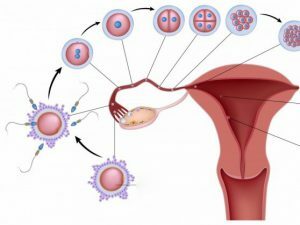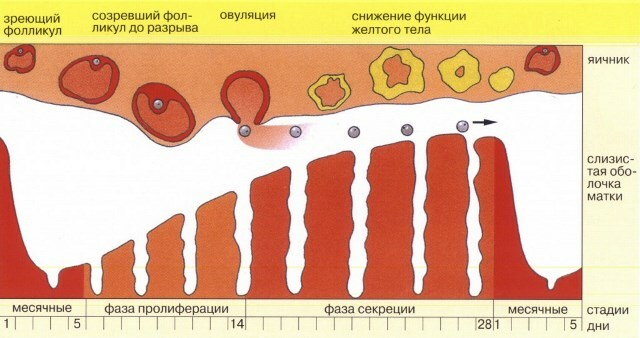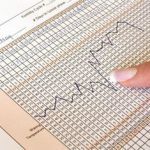The process of transition of a mature ovum from the ovary to the uterus in medical practice is called ovulation. It is for this period that up to 80% of conceptions occur, but even after ovulation, you can become pregnant. These two physiological functions of the female reproductive sphere are closely related. For a reliable family planning, a woman needs to have a general idea of the physiology of these processes.
What you need to know about ovulation
This term in the medical literature means just two concepts: the middle of the menstrual cycle andtime of movement of the egg through the tubes to the uterus. It is in the uterus that the mature female cell and the male sperm come into contact, which leads to the onset of pregnancy.
At the end of puberty in the female ovaries, up to 500 to 600 eggs are waiting for their time, they are laid there by nature at the birth of the girl. The first months are usually the beginning of the first ovulatory cycle. The possibility of getting pregnant at the age of 13 - 15 years is extremely small due to the inferiority of the hormonal background of the young girl, but this probability can not be discounted.
The menstrual cycle of a woman consists of several stages. The initial phase is considered the maturation of the follicle in the ovaries. It is in them is a new egg. This process usually takes 10 to 15 days, all depends on the duration of the cycle in the patient. At the end of development, the follicle envelope bursts, and the cell begins its journey into the uterine cavity.
In the period preceding ovulation, the hormonal system of a young woman actively stimulates the restructuring of the mucous and muscular tissue of the uterus to receive the egg. Cervix of the uterus expands, the membranes lining its walls, increase in size. Everything is ready for the fertilization of the egg and its placement for all the next 9 months.

If the conception does not occur for various reasons, the level of estrogens and progesterone in the blood of the girl drops sharply, which leads to a reduction in the walls of the uterus, rejection of excess endometrium and ejection of the egg together with menstrual blood.
. The probability of getting pregnant the next day after ovulation is quite high, soas at this time the uterus and the ovum are still ready to receive male sperm. If conception does not occur, most often the couple will have to wait for the next cycle to try again.
The main objective and subjective signs of ovulation
If a young lady is interested in the question of when to get pregnant - before or after ovulation, she needs to present the main features of this process. Many women easily determine the time of this phase of the menstrual cycle without special tests and calendars monthly. What is their secret:
- General condition of discomfort can be expressed by weakness, headache, abnormality of the digestive tract, swelling and hypersensitivity of the mammary glands. All these symptoms are caused by an increased content of sexual female hormones.
- At the time of rupture of the follicle membranes, many women report severe pain in the pelvic region, in 70-80% of cases, the pain syndrome occurs only on one side of the abdomen. The duration of this condition usually ranges from 15 minutes to 36 hours, it all depends on the physiological characteristics of the female body.
- A hormonal outbreak is always accompanied by various disorders from the CNS.In our case, the most likely symptoms are sharp mood swings, changes in taste, nervousness, or increased drowsiness. Nausea and vomiting are not excluded.
- The most common manifestation of ovulation is the woman's hypersexuality during this period. It is not by chance that most conceptions occur precisely during the period of transition of the egg into the uterus.
- External signs of the onset of the transition of the egg to the uterus can be abundant mucous discharge from the vagina, often with veins of dark blood.
If a woman regularly visits one gynecologist, then during this period a specialist can observe changes in the structure of her cervix. All these manifestations are physiological and should not cause anxiety in patients.
We calculate the favorable moment for conception on our own
According to various gynecological sites, one can get pregnant after ovulation and after a week. However, if a young family plans a pregnancy, you need to be able to calculate the time of the onset of a favorable moment. To achieve this goal, there are several options.
With a relatively regular cycle, most specialists recommend that women record body temperature data from 7 to 8 days of the cycle. The measurements are taken in the evening by an ordinary thermometer. It is desirable to fix the rectal temperature( in the pope).When ovulation occurs, the digits on the thermometer will first drop sharply, and after 5 to 6 hours will rise again. These changes will indicate the release of the ovum from the ovaries.
The next day after ovulation, the temperature regime of the female body comes to its physiological norm and remains unchanged until next month.

The whole problem of determining the optimal time for conception is that in most young patients the monthly cycle is constantly changing. These changes depend on a variety of factors. Physical stress, hypothermia, emotional stress, various diseases can shift the time of release of the egg into the uterus in both directions. In this case, the question "How many days after ovulation can I get pregnant?" Is very difficult to answer.
In medical practice, there have been cases when the duration of the monthly bleeding has reached 6 to 7 days for no apparent reason. This happens with a long menstrual cycle. A beneficial period for conception in this case is prolonged up to 4 - 5 days, and ovulation can begin only a week after menstruation.
To help a woman in this case can come laboratory methods of research. In these conditions, the determination of the content of the luteinizing hormone in the blood of the patient is conclusive. Its increase in 2 - 3 times is a clear symptom of the onset of ovulation.
Most expectant mothers simply do not have the time to take tests every day, so they have developed a method for determining the favorable phase of pregnancy for urine analysis. To do this, a special test is used, available on sale in the pharmacy network. This procedure resembles a pregnancy test: special paper strips are used, which are lowered into the vessel with urine for a few seconds. In the presence of two positive control bands, it can be argued that ovulation has occurred. The application of the method will allow any woman to increase the chances of becoming pregnant after ovulation.
We recommend reading the article on how to determine the day of ovulation. From it you will learn about the methods of calculation, the effectiveness of calendar and online methods, the use of tests, the measurement of basal temperature, the passage of ultrasound.
Is it possible to become pregnant after ovulation

Fertilization of the ovum after ovulation
As mentioned above, the time of release of the egg into the uterus is the most favorable period for conceiving a child. However, there is always the question: "What is the probability of getting pregnant after ovulation?" It all depends on the time.
Within 2 days the unfertilized egg simply begins to break down and is rejected from the uterine wall. In this case, the content of hormones in the woman's blood decreases, the rectal temperature comes to normal, and the process of conception becomes impossible in principle.
When a gynecologist is asked how many hours after the ovulation it is possible to become pregnant, he usually recommends that the first 12 be considered for conception. At this time, the egg's ability to fertilize remains high, and the conception process can go quite successfully.
Quite often there are situations when normal and regular ovulation does not end with pregnancy. The woman carefully calculates favorable days, observes all the recommendations of doctors, but the result remains negative. There can be several reasons for this:
- The most common problem in the patient itself. Perhaps the lack of development of the egg to the required size. This can be a woman's usual physiological condition or the consequence of breastfeeding.
- Various inflammatory diseases of the female genital area can also become an obstacle to the planned pregnancy. Obstruction of the fallopian tubes and cystic changes in the ovaries should cause the future mother to turn to the doctors for help.
- In the absence of pregnancy may be to blame and the future father. The number of active spermatozoa in one milliliter of sperm can be below the norm, which in our age of bad ecology and constant stress is not uncommon.
Any young family planning an addition to the family must first seek the advice of appropriate specialists. Doctors will conduct a full survey of the couple's reproductive health, give recommendations on the correct calculation of favorable days for conception. It should be remembered that pregnancy can not come by order, and any experience on this occasion will only lead to unnecessary emotional breakdowns, which can affect the regularity of a woman's menstrual cycle and reduce the likelihood of long-awaited pregnancy.


